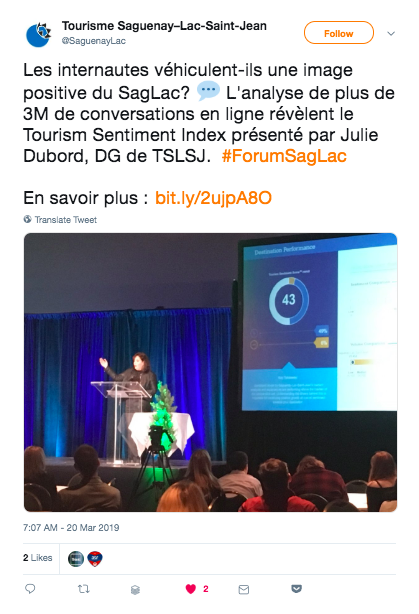Many destination marketers are using Tourism Sentiment Index (TSI) to find out what people are saying about their destinations and specific tourism assets. After a fall 2018 public release, more than 160 destinations have joined the initiative, and our team has collected and analyzed more than a billion conversations about these destinations and their competitors. The scope of the data and the analyses are staggering. But how are destination marketing organizations (DMOs) using TSI to solve their most pressing problems?
To find out, we asked some of our clients. Though it’s still early, they shared what they have already been able to accomplish thanks to new insights provided by the report.
Here are five ways these DMOs are using their reports to get the most out of sentiment analysis designed specifically for destination marketers.

Image credit: Kelsey Knight, Unsplash
1) Align stakeholders at AGMs or board meetings
These DMOs seized the day and shared the findings of TSI at public meetings shortly after receiving their reports.

Translation: Do Internet users convey a positive image of the SagLac? ? The analysis of more than 3M online conversations reveals the Tourism Sentiment Index presented by Julie Dubord, DG of TSLSJ.
The reports’ clear analyses and visualizations showed industry members and stakeholders what people are saying about the destination and its tourism assets. This rallying point led to greater alignment while giving credibility to the DMO’s vision and call to action.
At Tourisme Saguenay-Lac-Saint-Jean (Canada), Director General Julie Dubord showed an audience of stakeholders that the sentiment analysis of more than 3 million conversations confirms the DMO’s plan to generate more awareness of the local experiences that truly matter, which means focusing on the outdoor adventure product.
“As planned, we launched the event with the TSI report, and the reactions from the audience were fantastic,” Julie says. “First, they were very attentive throughout the presentation, and many came to see me afterward to tell me how relevant and eye-opening it had been for them. Plus, the media focused their news coverage on the report as a way of showing the strength of the tourism industry. Overall, some 300 people attended the forum, and the general impression is very positive. The entire team is very proud of what we have accomplished, and I am certain that your report helped consolidate our leadership in the region.”
Tourism Saskatchewan (Canada) used its report to avoid distractions and show that the core Saskatchewan experience is what matters. Niche markets like fishing and hunting are front and centre in this Canadian province.
“We use TSI to identify strengths and product opportunities where we can influence conversations and related sentiment. For example, Saskatchewan’s craft brewing is among the best anywhere, but our conversation volume is very low,” says Amy McInnis, Manager of Marketing at Tourism Saskatchewan.
“We also had some staff concerns that we would use TSI to divert resources toward certain product areas to the exclusion of others we have invested in. We have reaffirmed that this isn’t the case, but it does highlight potential opportunities where we are already performing well and/or can up our game.”
The data helps destination marketers make confident decisions about investments in tourism development and promotion alike. At Tourism Chilliwack (Canada), TSI’s detailed analysis is helping the DMO find alignment between its new brand and its marketing strategy.
Every destination’s Tourism Sentiment Index analyzes 50 categories of tourism assets, which provides incredible intel into specific strengths and weaknesses as visitors see them. The difference between conversation volume about restaurants, for example, illuminates not only perception of that destination’s visitors but also compares that to a competitive set. The report will be an essential benchmark for these DMOs as they proceed with their strategic planning and collaboration.
2) Prove value to stakeholders
DMOs are proud of the great work their industry and organizations are doing, and they’re using TSI to both celebrate success and respond to criticism.

Tara Bennett, Executive Officer at Tourism Port Douglas & Daintree
Your DMO can’t please everyone equally. But when stakeholders express concern, it helps to have data to back up your argument and show the value of your work. TSI provides just that.
Tourism Port Douglas Daintree (Australia) faced a challenge brought by a vocal group of opponents who questioned the DMO’s mission and success. Executive Director Tara Bennett told us that her report showed increasing positive sentiment for the destination and the experiences on offer. The report gave her the evidence she needed to defend the work her DMO has been doing and continue with the confidence that they are on the right path. “The report was a cost-effective way to take an unbiased look in the mirror,” she said in an interview.
TSI is making an impact for destination marketers in other ways too:
3) Support funding applications
Some DMOs are using TSI to illustrate their performance in support of successful requests for funding. The report gives destination marketers hard data to support their business cases and demonstrate why a specific opportunity demands attention and investment. So far, we’re only aware of DMOs who’ve used their data to secure government funding, but some of our more progressive partners are already exploring public-private partnerships backed by TSI data and insights.
4) Plan at the state or provincial level
State-level planning requires leadership that unites many stakeholders in a coordinated fashion. When everyone is working from consistent, easy-to-understand research, information and analysis, that path becomes much more manageable. State and provincial DMOs are using TSI to do just that. For example, Colorado Tourism Office used sentiment analysis of 18.7 million conversations to support its state-wide branding initiative in a project Destination Think completed prior to TSI’s release.
5) Show the positive impact of tourism on a place’s brand and celebrate success
“Why is tourism important?” some stakeholders may ask. TSI shows that, almost always, tourism has an undeniably powerful impact on word of mouth and perception about an overall place. It’s a good news story for any destination marketer.
What’s more, the report provides an opportunity for destinations to shine a spotlight on their successes, both internally and out in the world through various media. The data tells you which experiences your visitors love the most, which rank in the top percentile globally and how your destination is trending compared to competitors. Marketers enjoy using their report as a source of positive announcements to motivate and inspire their destination’s industry.
This post has been updated with additional examples since it was first published.










0 Comments